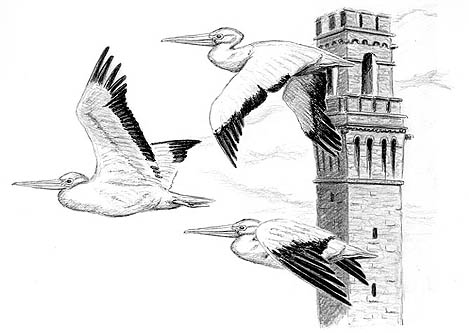
Dear Bird Folks:
I heard about a flock of white pelicans that was seen in Provincetown last week. I would like to see them. Are they still around? Why are they so far out of their normal range? And will they be in trouble when the weather gets colder?
-Scott, Eastham
You Know Scott,
One of the nice things about watching birds is that every once in a while a rare bird arrives that is so distinct that all of us can actually identify it. All too often the rare birds that mistakenly visit here look so similar to the native birds that you need a police lab to identify them. Only the eggheads have the skills needed to identify most of our rare visitors while the rest of us must take their word for it. But then, just when we think watching birds is too difficult, along comes a bird that is so unmistakable that even the guy working in the pit at Jiffy Lube can identify it. The American White Pelican is just that kind of bird. It is massive, majestic and unique in every way. It is brilliant white, with a huge bill and a wingspan of over nine feet. If anyone out there has trouble identifying this bird, you are in need of some serious Lasik eye surgery.
Last Sunday I got a call from an excited Scott Landry, at the Center for Coastal Studies in Provincetown, telling me about a flock of white pelicans that he had just seen flying in front of the Pilgrim Monument. A few minutes later he e-mailed me a set of amazing photos that showed the pelicans gliding over Provincetown with the monument in the background. Ten minutes after that, a frenzied Provincetown lady named Eve, called me to report the same white pelicans. Even though I knew that her sighting was confirmed, I wasn’t about to let her know that. With a serious tone I tried to convince her that what she had seen was probably just somebody’s laundry blowing on the line or perhaps a flock of overfed gulls on their way to “Curves.” Her defiant screams could be heard as far away as Cranston, RI.
The white pelican is indeed rare here in the East, but every few years they make a cameo. It seems to me that four or five years ago a small flock visited the Mid Cape area, or at least I think they did. Suddenly I’m not sure if I dreamt it or not. I’ll have to look it up. Most white pelicans breed in the western-central section of North America and then head to the southern U.S. coast for the winter. For whatever reason, a few of the fall migrants occasionally take the long route south and that’s when we get to see them.
White pelicans are considerably different than those prehistoric looking Brown Pelicans that hang around the boats in Florida. White pelicans are very elegant looking birds, almost swanlike. They ride very high and stately in the water and soar gracefully in fight. White pelicans don’t make those crazy plunge dives like their brown cousins. They hunt by forming a synchronized semicircle. With their bills lowered into the water they “herd” the fish towards the shores. Once the fish are in the shallow water the scooping begins. If there is only a pair of pelicans, the two birds will face off and herd the fish towards each other. And if a pelican is all alone, it will often hire a border collie to help herd the fish towards its mouth.
White pelicans love each others company. They nest together, they roost together, they feed together and apparently, since you saw five of them in Provincetown, they get lost together. I read a sweet story of a pelican that had gone blind and could no longer hunt. Instead of allowing it to die, the other members of the flock continuously brought it food to keep it from starving. This next part is even more amazing. When it became time for the blind pelican to migrate, the other birds chipped in to pay for its cab ride to Florida.
The good news for the birds is that they are strong flyers and I’m sure that it will be only a matter of time before they safely work their way south. The bad news for you and other birders, Scott, is that the pelicans have yet to settle down anywhere where we can reliably go see them. But that’s what makes birding so much fun. On any given day, on any given spot, something rare could pop up. You just never know what bird you might see whenever you look towards the sky or into the window of a passing cab.